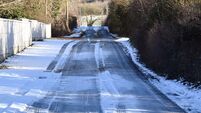'Triple dip' La Niña to wreak havoc with global weather patterns

Irish humanitarian organisations joined forces to sound the alarm on the risk of widespread famine in the Horn of Africa at Leinster House in June. Picture: Stephen Collins/Collins Photos
A rare "triple dip" weather phenomenon is likely to wreak havoc with weather patterns across the globe for the winter, scientists have warned.
The World Meteorological Organization (WMO) warned the northern hemisphere was now braced for the third winter of the La Niña water cooling phenomenon, while the southern hemisphere's summer months will be affected.
Opposite to the warming El Niño pattern, La Niña refers to the large-scale cooling of the ocean surface temperatures in the central and eastern equatorial Pacific Ocean, coupled with changes in the tropical atmospheric circulation, namely winds, pressure and rainfall, the WMO said.
That means exacerbating drought and flooding in different parts of the world as some regions become hotter and others wetter than normal, it warned.
WMO secretary-general Prof Petteri Taalas said:
“The worsening drought in the Horn of Africa and southern South America bear the hallmarks of La Niña, as does the above average rainfall in South-East Asia and Australasia. The new La Niña update unfortunately confirms regional climate projections that the devastating drought in the Horn of Africa will worsen and affect millions of people.”
The WMO warned in recent days that the Greater Horn of Africa is bracing for a fifth consecutive failed rainy season, which will worsen the crisis impacting millions of people.
Drought-affected areas of Ethiopia, Kenya, and Somalia are expected to receive significantly below normal rainfall totals through until the end of the year.
“It pains me to be the bearer of bad news, when millions of people in the region have already suffered the longest drought in 40 years. Sadly, our models show with a high degree of confidence that we are entering the fifth consecutive failed rainy season in the Horn of Africa.
"In Ethiopia, Kenya, and Somalia, we are on the brink of an unprecedented humanitarian catastrophe,” said Dr Guleid Artan of the WMO’s regional climate centre for East Africa.
Australia, coming into its warmer months, has also been adversely affected by La Niña events in recent years.
In 2010, it took place as one of the worst ever floods in the Queensland region, with about 10,000 evacuations from local homes and a damage bill of about €2bn.
A ‘triple dip’ La Niña — lasting three years in a row — has happened only twice since 1950, according to the leading scientific journal .
The El Niño and La Niña events have been stronger since 1950 than previous centuries, data show, but scientists are still trying to ascertain if this is due to natural events or climate change.
Check out the Irish Examiner's WEATHER CENTRE for regularly updated short and long range forecasts wherever you are.













